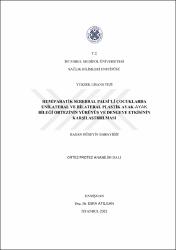| dc.contributor.advisor | Atılgan, Esra | |
| dc.contributor.author | Babayiğit, Hasan Hüseyin | |
| dc.date.accessioned | 2022-01-21T08:32:31Z | |
| dc.date.available | 2022-01-21T08:32:31Z | |
| dc.date.issued | 2021 | en_US |
| dc.date.submitted | 2021-06-28 | |
| dc.identifier.citation | Babayiğit, H. H. (2021). Hemiparatik serebral palsili çocuklarda unilateral ve bilateral plastik ayak-ayak bileği ortezinin yürüyüş ve dengeye etkisinin karşılaştırılması. (Yayınlanmamış yüksek lisans tezi). İstanbul Medipol Üniversitesi Sağlık Bilimleri Enstitüsü, İstanbul. | en_US |
| dc.identifier.uri | https://hdl.handle.net/20.500.12511/8878 | |
| dc.description.abstract | Bu çalışmanın amacı; hemiparatik Serebral Palsi (SP)' li çocuklarda kullanılan plastik ayak-ayak bileği ortezi (AFO) nun unilateral ya da bilateral kullanımının çocuğun yürüyüşüne ve dengesine etkisini incelemektir. Çalışmaya bilateral AFO kullanan, yaşları 4-12 yıl arasında, kaba motor fonksiyon sınıflandırma sistemine göre seviyesi 1 ve 2 olan, koopere 19 çocuk dahil edildi. Çocuklar bilateral/ unilateral AFO'lu ve AFO'suz değerlendirildi. Zamanlı Kalk Yürü Testi (ZKYT), Pediatrik Berg Denge Ölçeği (PBDÖ), Bertec Balance kuvvet platformunda gözler açık ve kapalı olacak şekilde gövde salınım değerlendirmesi ve GAİTRite elektronik yürüme yolu ile yürüyüşün zaman mesafe karakteristikleri değerlendirildi. Sonuç olarak; ZKYT'de unilateral AFO ile ölçümünün bilateral AFO ölçümünden anlamlı düzeyde daha düşük olduğu görülmüştür (p<0,05). Hastaların PBDÖ'de istatistiksel olarak anlamlı bir fark bulunmadı (ATİ=2,389, p=0,100). Bertec cihazıyla yapılan değerlendirme sonucunda gözler açık (GzA) normal zemindeki lateral sallanma aralığı (NZ-LSA) bilateral AFO ile yapılan ölçümde anlamlı düzeyde azalmıştır (p<0,05). Ayrıca gözler kapalı (GzK) NZ-LSA değeri bilateral AFO ölçümünde cihazsız ölçüme kıyasla anlamlı düzeyde azalmış (p<0,05), unilateral AFO ile ölçüme göre ise anlamlı bir fark bulunmamıştır. GAITRite elektronik yürüme yolu değerlendirmesinde ise; adım süresi ortalaması, sağlam ve etkilenmiş tarafta bilateral AFO varken en yüksek değere sahiptir; (p<0,05). Adım uzunluğu, çift destek periyodu, sallanma ve destek fazı ölçümleri, ölçüm yapılan taraf ya da duruma göre anlamlı düzeyde farklılık göstermemiştir (p>0,05). Hız ortalaması ölçümlerinde anlamlı bir fark bulunmamıştır. Bilateral AFO varken elde edilen kadans diğer iki duruma göre istatistiksel olarak anlamlı düzeyde daha düşük olduğu belirlenmiştir (p<0,05). Sonuç olarak; bilateral AFO statik duruş sırasında daha dengeli bir basma sağlamasına bağlı olarak dengeyi arttırıyor, yürüyüş esnasında unilateral AFO kullanımına kıyasla hızı düşürüyor. | en_US |
| dc.description.abstract | The purpose of this study is to investigate the effect of unilateral and bilateral usage of plastic ankle-foot orthotics (PAFO) on balance and gait in children with hemiparetic cerebral palsy (CP). A total of 19 cooperative children, between the ages of 4 and 12 years, who used bilateral AFOs and were grades 1 and 2 according to the gross motor function classification system, were included in the study. Children were evaluated with and without bilateral/unilateral AFO. The time-distance characteristics of gait were evaluated with the Timed Up and Go Test (TUG), Pediatric Berg Balance Scale (PBBS), trunk oscillation assessment with eyes open and closed on the Bertec Balance force platform, and the GAITRite electronic walking path. The unilateral AFO measurement in the TUG test was significantly lower than the bilateral AFO measurement (p<0.05). There was no statistically significant difference in the PBBS of the patients (ATI=2.389, p=0.100). As a result of the evaluation made with the Bertec device, the normal ground-lateral sway range (NG-LSR) with eyes open (EO) decreased significantly (p<0.05). Moreover, there was no significant difference between unilateral and bilateral AFO measurements when comparing the NG-LSR value with eyes closed (EC) without the Bertec device (p<0.05). In the GAITRite electronic walking path evaluation, the mean step time had the highest value when there was bilateral AFO on the healthy and affected side (p<0.05) Stride length, double support period, swing, and support phase measurements did not differ significantly by measuring side or condition (all p>0.05). There was no significant difference in mean velocity measurements. The cadence obtained in the presence of bilateral AFO was found to be significantly lower than the other two conditions (p<0.05). As a result, compared to using unilateral AFO, bilateral AFO increased balance due to providing a more balanced step during static stance and decreased speed during walking. | en_US |
| dc.language.iso | tur | en_US |
| dc.publisher | İstanbul Medipol Üniversitesi Sağlık Bilimleri Enstitüsü | en_US |
| dc.rights | info:eu-repo/semantics/openAccess | en_US |
| dc.subject | AFO | en_US |
| dc.subject | Denge | en_US |
| dc.subject | Serebral Palsi | en_US |
| dc.subject | Yürüyüş Analizi | en_US |
| dc.subject | AFO | en_US |
| dc.subject | Balance | en_US |
| dc.subject | Cerebral Palsy | en_US |
| dc.subject | Gait Analysis | en_US |
| dc.title | Hemiparatik serebral palsili çocuklarda unilateral ve bilateral plastik ayak-ayak bileği ortezinin yürüyüş ve dengeye etkisinin karşılaştırılması | en_US |
| dc.title.alternative | Comparison of the effects of unilateral and bilateral plastic ankle-foot orthosis on gait and balance in children with hemiparetic cerebral palsy | en_US |
| dc.type | masterThesis | en_US |
| dc.department | İstanbul Medipol Üniversitesi, Sağlık Bilimleri Enstitüsü, Ortez ve Protez Ana Bilim Dalı | en_US |
| dc.relation.publicationcategory | Tez | en_US |


















